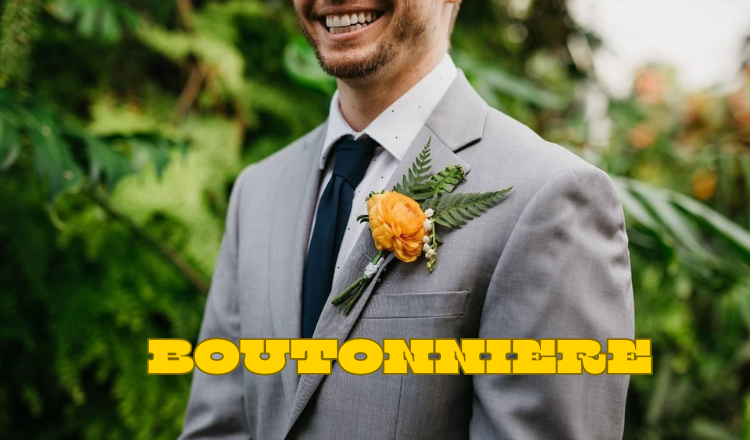A boutonniere is not just a small floral accessory; it is a symbol of elegance, tradition, and personal style. Whether you are planning a wedding, attending a formal event, or simply wishing to elevate your sartorial game, understanding the nuances of a bouton niere can make a significant difference. This comprehensive guide will explore the history, selection, creation, and wearing of bouton niere , ensuring that you can create and sport this timeless piece with confidence.
History of the Boutonniere
The term boutonniere comes from the French word for buttonhole. Historically, men wore bouton niere to fend off disease and bad luck. Over time, they evolved into a staple of men’s formalwear, particularly in wedding attire and special occasions.
Evolution Through the Ages
- Ancient Times: Initially, flowers were worn for their fragrance and believed to possess protective powers.
- Medieval and Renaissance Eras: Knights wore their lady’s colors upon their chest, which later transformed into floral decorations.
- 19th Century: bouton niere became a staple in men’s formalwear, especially in the Victorian era, symbolizing refinement and class.
Selecting the Perfect Boutonniere
Choosing the right bouton niere involves more than just picking a flower. It requires consideration of the event, the attire, and personal preferences. Here’s how to make an informed choice:
Understanding Floral Symbolism
Each flower carries its own meaning and can convey specific emotions:
- Roses: Represent love and passion. Red roses are classic for weddings, while white roses symbolize purity.
- Carnations: Versatile and available in many colors, they represent love, fascination, and distinction.
- Orchids: Exotic and elegant, orchids symbolize beauty and strength.
- Lily of the Valley: Represents happiness and is often used in weddings for its delicate appearance and sweet fragrance.
- Baby’s Breath: Symbolizes innocence and is commonly used as a filler to add texture and volume.
Matching with Attire
The bouton niere should complement the wearer’s outfit:
- Color Coordination: Match the bouton niere with the tie or pocket square. For instance, a white rose works well with a black tuxedo, while a more vibrant flower can add a pop of color to a less formal suit.
- Size and Proportion: Ensure the bouton niere is proportionate to the wearer. Smaller bouton niere are more subtle and elegant, while larger ones make a bold statement.
Creating a Boutonniere
Crafting a bouton niere is an art that involves a few simple steps. Here’s how to create your own:
Materials Needed
- Fresh flowers of your choice
- Floral wire and tape
- Scissors
- Ribbon (optional)
- Pin
Step-by-Step Guide
- Prepare the Flowers: Trim the stems to about 2-3 inches long. Remove any excess leaves or thorns.
- Wire the Flowers: Insert a floral wire through the base of each flower head, leaving about an inch of wire on each side. Bend the wire down the stem.
- Tape the Stems: Using floral tape, wrap the stems and wire tightly from top to bottom, ensuring the flowers are securely in place.
- Add Filler: Incorporate smaller filler flowers like baby’s breath or greenery around the main flower. Tape these in place as well.
- Finish with Ribbon (Optional): Wrap a ribbon around the taped stems for a polished look. Secure the end with a dab of glue or a small knot.
- Attach the Pin: Place the pin through the ribbon and floral tape, ensuring it’s secure enough to attach to the lapel.
Wearing a Boutonniere
Wearing a bouton niere correctly is crucial to maintaining a polished appearance. Here are some guidelines:
Placement
- Left Lapel: Traditionally, bouton niere are worn on the left lapel of a suit jacket, closest to the heart.
- Proper Angle: Ensure the flower is facing outward and slightly upward.
Securing the Boutonniere
- Use a sharp pin to attach the bouton niere securely. Insert the pin from behind the lapel, through the stem, and back into the fabric.
- For added security, you can use a second pin, crossing the first to form an X.
Boutonniere Etiquette and Traditions
Understanding the etiquette surrounding bouton niere can add a touch of class to any event.
Weddings
- Groom and Groomsmen: The groom’s bouton niere should stand out, often matching the bride’s bouquet. Groomsmen wear smaller, coordinating bouton niere.
- Fathers and Grandfathers: It’s customary for the fathers and grandfathers of the bride and groom to wear bouton niere, often simpler versions of the groom’s.
- Visitors: Unless the couple specifically requests it, male guests typically do not wear bouton niere.
Formal Events
- Proms and Dances: A young man often wears a bouton niere that matches his date’s corsage.
- Black-Tie Events: A simple, elegant bouton niere, such as a white carnation or rose, is appropriate.
Maintaining Freshness
A wilted bouton niere can detract from your appearance. Follow these tips to keep it fresh:
- Hydration: Keep the stems in water until just before wearing.
- Refrigeration: Store the bouton niere in the refrigerator, away from fruits and vegetables, to maintain its freshness.
- Spritzing: Lightly mist the flowers with water to keep them hydrated throughout the event.
Conclusion
Crafting and wearing a bouton niere is a timeless tradition that adds a touch of elegance and personal style to any formal attire. By understanding the history, selection process, and proper etiquette, you can confidently incorporate this accessory into your wardrobe. Whether for a wedding, prom, or black-tie event, a well-chosen bouton niere will ensure you stand out with grace and sophistication.




